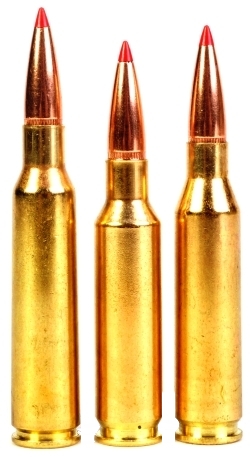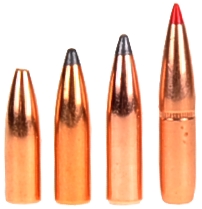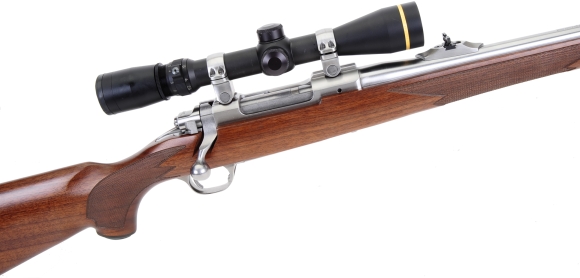 I like to think I am a rational man, but then I suspect most people think the same of themselves. The advantage I hold in making my case is that I can prove it. If I have been able to make clean, one shot kills on game with simple copper jacketed, lead core bullets of appropriate selection for going on the past 60 years, why do I need to switch to bullets that look like miniature rocket ships or guided missiles that cost three to four times as much?
I like to think I am a rational man, but then I suspect most people think the same of themselves. The advantage I hold in making my case is that I can prove it. If I have been able to make clean, one shot kills on game with simple copper jacketed, lead core bullets of appropriate selection for going on the past 60 years, why do I need to switch to bullets that look like miniature rocket ships or guided missiles that cost three to four times as much?
Yes, I do realize that outside of the United States… say in California, they cannot use lead core bullets and may soon be restricted to shooting paper clips with elastic bands stretched between thumb and forefinger, but I elected to put California in my rear view mirror over fifteen years ago. So why do I have to live by someone’s nutty uncle, Jerry Brown’s rules? I don’t.
I live in Maine… where the trees are a few feet apart, shooting distances are typically under one hundred yards and an 18 1/2″ barrel rifle that can shoot a moderate powered cartridge sub MOA is more than enough gun for anything I’ll encounter. Not much different from most of the eastern states… except Tennessee, but only because I don’t know much about that state. Wait, I looked it up on Google. We can include Tennessee.
Ruger’s M77 Mark II International 260 Remington is an excellent example of the previously defined firearm and it is sitting on the bench, so it seemed only natural to put it to good use. A somewhat compact 8x scope was mounted and then scrounging through reloading components commenced.

For the sake of context, and because no article with the topic of reloading can be called complete without lots of cartridges lined up to demonstrate that the author has handloaded more than one cartridge, I offer into evidence the 6.5x55mm Swede – modest crowd cheering, the 6.5 Creedmoor – frenzied applauds and the 260 Remington – Is that a pin I heard drop? Yes, the 260 Remington is not one of the 308 Winchester parented siblings that people brag about. Why not? I don’t know as it is a hot rod in its own right.
The 260 Remington dates back to 1962 and Ken Waters 263 Express wildcat. For folks who shoot competitively, the 260 Remington is a terrific cartridge. For people who hunt white tail deer, black bear and hogs, it is a terrific cartridge. Flat shooting, good power and it usually finds its way into accurate firearms. Still, it seems skipped over in social media when the discussion turns to favorite cartridges. I have a friend who brings a box of 264 Winchester magnum ammo to lay on the bench at the range, just so he won’t have to explain for the thousandths time why he owns a 260 Remington. Yes, I did just make up that last part.
My personal firearms chambered for the 260 Remington have has barrel lengths from 18 1/2″ to 26″. The former a lightweight that added little to the effort of working through dense tree growth and brush or walking hills in pursuit of the wily… almost everything. The latter, a heavy barrel target rifle that could reach well beyond 1,000 yards with bullets remaining supersonic.
From a handloaders perspective, the biggest difference was bullet selection. For the short barrel rifle, like the subject rifle, I typically shot the bullet that follow. For the target rifle, I used almost exclusively Laupa Scenar L 136 grain and Nosler Custom Competition 140 grain, neither which were suitable for any of my hunting applications.
 Left, from left to right:
Left, from left to right:
Sierra Varminter 100 grain JHP – Sierra recommends this bullet for hunting anything from varmints up through medium size game and for 6.5mm cartridges from the 6.5 TCU through to the 264 Winchester Magnum. That is a whole lot of coverage, Sierra is a good company, so I am sure their application suggestions are accurate and the bullet is accurate.
I’ve not used this bullet on deer size game because of bullet construction. The 0.264″ bullet is slick at most bullet weights, an 0.260 BC in this case. With a 24″ barrel and 3,200 fps of muzzle velocity it is deer worthy out to 300 yards; 2,161 fps and 1,037 ft.lbs. of kinetic energy. On a 3″ ordinate, point blank range is 265 yards with a 7″ drop at 300 yards.
Sierra Pro-Hunter 120 Grain JSP – Sierra defines this as a bullet for 6.5×284 and 264 Winchester Magnum for longer ranges, indicating the jacket is too fragile for close in shooting with these cartridges. They make no reference to cartridges like the 6.5x55mm or the 260 Remington. From my personal experience, it has proven to be excellent for medium size game and quite accurate. The flat base preserves net case powder capacity and its 0.356 BC gives it higher velocity and greater energy, and it is as flat shooting as the 100 grain Sierra bullet at 300 yards.
Nosler Partition 125 grain JSP – Nosler suggests a minimum impact velocity of 1,800 fps and a maximum of 3,200 fps, neither of which are a problem for the 260 Remington within the 300 yard range being considered. Muzzle velocity will not exceed 2,900 fps nor fall below 2,000 fps at 300 yards. On a +3″ ordinate, point blank range is approximately 260 yards. The dual core construction and tapered jacket are tough, allowing good controlled expansion without fragmentation.
Hornady SST 140 grain JPTBT – “JPT” is “Jacketed Poly Tip Boat Tail”. Essentially this is a lead core, one piece tapered jacket with a pointed polymer insert to streamline its form. The boat tail doesn’t really do much to make the heel of the bullet stream lined as much as it shifts weight and the bullet’s center of pressure rearward, allowing for a more streamlined tip. Hornady recommends this bullet for medium, 50 – 300 lbs, and large, 300 – 1500 lbs. While the bullet’s weight reduces muzzle velocity to something on the order of 2700 fps, the bullet has a very high BC of 0.520. Subsequently, point blank range is reduced to 246 yards, which is still far more than required, but 300 yard velocity/energy is an admirable 2205/1512.
So why not just put URL links to the respective reloading manual and call it a day? Because the Ruger is a carbine with an 18 1/2″ barrel, not the 24″ barrel manufacturers’ manuals cite, and SAAMI spec for test barrel length, so we’d be left with nothing more than theory and conjecture… the pillars upon which I built most of my early career…s. No, we are pressing on with a real firearm, real handloads, a real chronograph, and real targets to back up my conclusions.
Handloads
| Bullet | Type | Weight Grains |
Bullet Length” |
Ref COL” |
Max COL” |
Adj COL |
| Sierra Varminter | JHP | 100 | 0.930 | 2.710 | 2.665 |
2.650 |
| Sierra Pro-Hunter | SPFB | 120 | 1.080 | 2.765 | 2.763 |
2.745 |
| Nosler | SPFB | 125 | 1.180 | 2.800 | 2.771 |
2.755 |
| Hornady SST | PTBT | 140 | 1.395 | 2.775 | 2.840 |
2.775 |
OK, Joe, now you’re just making up table headers… Yes, but with a good excuse. There are not a lot of absolutes when it comes to handloading, other than if you are careless and make a lot of assumptions you will eventually end up with a pile of scrap metal or worse. So a lot of checking and small tools that allow checking work well together as a system of scrap prevention.
From the table above – “Ref COL”” is the recommended cartridge overall length from the respective bullet manufacturer’s reloading data. “Max COL”” is the maximum COL permitted by the rifle’s chamber and throat as measured with a COL gauge. “Adj COL” is the “Max COL”” minus a safely rounded 0.015″ to make sure the bullet is not sitting on the rifling leade. Why? A bullet without room to moderate start pressure typically will significantly pressure spike, which requires a change in charge data to compensate. There is no need to park a bullet against rifling in a sporting rifle as it will never, never… never result in a measurable improvement in accuracy, any more than lowering the front of a car to emulate a drag car will make it go faster.
None of the manufacturer COL cites held up, other than Hornady’s which seated to their bullet’s cannelure. The manufacturer wasn’t wrong, it is only a reference dimension to explain what they did, but their test firearm or universal receiver and test barrel could have had a maximum spec throat or opened up by test traffic erosion. So you begin with their information and build upon it with additional information.
And when the smoke cleared, the finalists looked a lot like this….
Warning: Bullet selections are specific, and loads are not valid with substitutions of different bullets of the same weight. Variations in bullet length will alter net case capacity, pressure and velocity. Primer selection is specific and primer types are not interchangeable. These are maximum loads in my firearms and may be excessive in others. All loads should be reduced by 5% as a starting point for development where cartridges have greater than 40 grains in capacity and 10% for cartridges with less than 40 grain capacity following safe handloading practices as represented in established mainstream reloading manuals. Presentation of these loads does not constitute a solicitation for their use, nor a recommendation.
| Cartridge – 260 Remington |
|
| Firearm | Ruger M77 MK II Intl |
| Barrel Length | 18.50″ |
| Min – Max Case Length | 2.035″ +0.000″/-0.020″ |
| Min – Max COL | 2.530″ – 2.800″ |
| Primer | Remington 9 1/2 |
| Bullet Diameter | 0.2645″ +0.000″/-0.0030″ |
| Reloading Dies | Redding FL |
| Bullet Type | Bullet Weight Grains |
Net H2O Grains Capacity |
COL” | Powder Type | Powder Charge Grains |
Muzzle Velocity fps |
Muzzle Energy ft/lbs |
100 YD 3 Shot “ |
| Sierra Varminter | 100 | 49.2 | 2.650 | Reloder 15 | 44.0 | 2945 | 1926 | 0.9 |
| Sierra Varminter | 100 | 49.2 | 2.650 | Reloder 16 | 47.0 | 2953 | 1937 | 1.1 |
| Sierra Varminter | 100 | 49.2 | 2.650 | Win 748 | 43.5 | 2962 | 1949 | 0.6 |
| Sierra Pro-Hunter | 120 | 48.4 | 2.745 | Reloder 16 | 45.0 | 2740 | 2001 | 0.9 |
| Sierra Pro Hunter | 120 | 48.4 | 2.745 | H414 | 45.5 | 2929 | 2287 | 0.9 |
| Sierra Pro Hunter | 120 | 48.2 | 2.745 | Win 760 | 45.5 | 2835 | 2142 | 0.7 |
| Nosler Partition | 125 | 47.2 | 2.755 | Reloder 16 | 44.0 | 2709 | 2037 | 0.8 |
| Nosler Partition | 125 | 47.2 | 2.755 | Hybrid 100V | 44.0 | 2717 | 2049 | 1.0 |
| Nosler Partition | 125 | 47.2 | 2.755 | H4350 | 44.5 | 2702 | 2027 | 1.0 |
| Hornady SST | 140 | 44.7 | 2.775 | Reloder 16 | 41.5 | 2565 | 2046 | 1.0 |
| Hornady SST | 140 | 44.7 | 2.775 | IMR7828SSC | 47.0 | 2650 | 2184 | 0.7 |
| Hornady SST | 140 | 44.7 | 2.775 | Norma MRP | 47.0 | 2598 | 2099 | 0.9 |
Assembly was straight forward. Redding dies set made quick work of things; they make a really nice product. Brass was once used Norma, full length resided. Standard Remington large rifle primers were used for all loads. Prep was decap and size, vibratory clean, trim, chamfer case mouth inside and out.
These cases are not dirty. If anything, the case neck discoloration and radial sizing squeezed lube rings demonstrate… character of brass and press handle effort. No compressed loads. The Sierra 120 grain H414 load is a tad warm, as indicated by the ejector bolt hole slight tattoo on the case head. I think I have a lot of H414 that is warmer than usual, so double check following standard routine.
 Re16 was brought in for this project as it is touted by Alliant as a great powder for 30-06 Springfield based cartridges and 6.5mm target rounds. It proved to be a bit of a disappointment. The charges listed on the table are heavier than suggested by Alliant Powder and, even when factoring for the shorter barrel, and handloads would have done as well if not better with Re15 and Re17.
Re16 was brought in for this project as it is touted by Alliant as a great powder for 30-06 Springfield based cartridges and 6.5mm target rounds. It proved to be a bit of a disappointment. The charges listed on the table are heavier than suggested by Alliant Powder and, even when factoring for the shorter barrel, and handloads would have done as well if not better with Re15 and Re17.
These days, Alliant is busy creating new powder numbers to create a need for three types of powder where one can competently get the job done. Many of the new listing are accompanied with recipes that show totally unrealistic gains over established product that are not born out in use. If a powder type picks up 200 fps over the established product, either the pressure is not equal or someone has an overly enthusiastic chronograph.
For the longest time Re7, Re19, Re22 and Re25 covered most mid to overbore magnum rounds. Re10x and Re17 were useful additions, 45-70 and moderate capacity magnums respectively. Re16, Re23, Re26, and Re33 mostly sit on the shelf as unnecessary.
I should not be singling out Alliant as this has become common practice with all of the powder suppliers. Too many introductions that are not meaningful to the average handloader, that is mostly an effort to get sales where people are sitting on established product powder inventory.
Factory ammunition was fired to baseline performance. Federal Vital-Shok with 120 grain Nosler Ballistic Tip bullet is rated at 2950 fps and yielded 2,748 fps from the Ruger; 24″ test barrel compared to 18.5″ Ruger rifle barrel, a 202 fps difference with 5.5″ barrel length difference.
Conclusions
So I put on a classic, Shark Attack: Megalodon, to get into a contemplative mood…
The Ruger M77 MKII International is a stout, but fast handling carbine. For anyone hunting where under 200 yards is planned, the shorter barrel carries little penalty… some surrender of velocity, and some significant advantages… light carry, fast handling. So lets look at the effects of velocity loss. We’ll do it with factory ammo in the event handloading is not in the equation.
As rated with a 24″ barrel, the 120 grain Federal factory load leaves the muzzle at 2,950 fps. With a 200 yard zero, the bullet never rises more than 1.6″ above line of sight, is on target at 200 yards, where it is traveling 2,555 fps and producing 1,740 ft.lbs of energy.
As recorded with the Ruger’s 18.5″, the same Federal ammunition leaves the muzzle at 2,748 fps. With a 200 yard zero, the bullet never rises more than 1.9″ above line of sight, is on target at 200 yards, where it is traveling 2,370 fps and producing 1,497 ft.lbs of energy. Clearly the differences are measurable, but would not be the difference in dropping a white tail or not. For the handloader, much of that lost ground can be recovered. For most northeastern woodland hunters, 100 yards or less is a more typical shooting distance where the practical ballistic difference is even less.
Ruger has done a great deal to refine performance of their firearms in materials, process and precision of parts and assembly. They may look very similar from one year to the next, but there have been hundreds of revisions contributing to ever better accuracy and reliability. The Ruger M77 MK II in 260 Remington is an excellent hog, deer and black bear combination and a rock solid firearm.



Email Notification